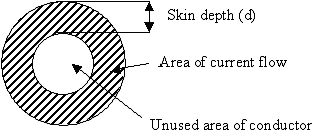
Skin effect can be defined as the tendency of high frequency currents to flow along the outer surface of a conductor, thereby restricting the current to a smaller part of the total cross-sectional area and increasing the effective resistance.
The extent of this effect is determined by the ”skin-depth” at that frequency. Referring to the figure the current tends to flow through shaded area of the conductor. The rest of the conductor is thus wasted space.

Skin effect causes current to flow along the outer edges of a conductor.
Since this skin depth is constant (at the given frequency) it is beneficial to parallel 2, 3 or 4 strands of smaller gauge wire, which reduces the unused area of copper. This is also referred to as multi-filar windings, and consists of bifilar (2) trifilar (3) or quadfilar (4) construction. In many cases construction limits the maximum number of parallel wires due to crowding and difficulties in termination on bobbin pins.